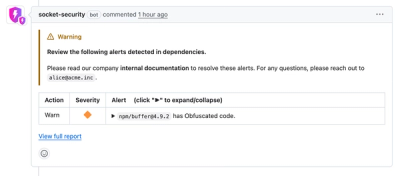
Security News
Crates.io Users Targeted by Phishing Emails
The Rust Security Response WG is warning of phishing emails from rustfoundation.dev targeting crates.io users.
ser1.net/claphelp/v2

A pretty Usage-printer and manpage generator for programs that use the claptrap flags library.

package mytest
require ser1.net/claptrap/v4
require ser1.net/claphelp/v2
For pretty-print usage, in your project:
package main
import "ser1.net/claptrap/v4"
import "ser1.net/claphelp/v2"
func main() {
reg := claptrap.Command("tripl", "Load a file a number of times")
// Set up the flags normally, .Add, AdCommand, etc.
reg.Add("!file", "a file name")
reg.Add("--count", "-c", 3, "times to read the file")
reg.Add("--action...", []string{"bytes", "words", "lines"}, "count the number of something in the file")
// Override the usage and error printing functions
claptrap.Usage = claphelp.PrettyUsage
claptrap.HandleErrors = claphelp.PrettyErrors
// Parse and use Usage as normal, e.g. reg.Parse(nil)
claptrap.Usage()
}
To generate manpages, use the magic environment variable CLAPTRAP_USAGE_JSON with your program's Usage and pipe the output through claphelp's cmd/makeclapman:
Note: you do not need to import claphelp into your project if all you want to do is generate manpages. Base claptrap understands the CLAPTRAP_USAGE_JSON environment variable. You need to import claphelp only if you want pretty-print help/error messages.
$ go install ser1.net/claphelp/cmd/makeclapman
$ CLAPTRAP_USAGE_JSON=true myprogram | makeclapman

makeclapman will generate one man page per subcommand in your program; for example:
root := claptrap.AddCommand("myprogram", "This is my program")
help := root.AddCommand("help", "Show my program's usage")
lotto := root.AddCommand("lotto", "Show winning lottery numbers")
will generate:
with "See also" references in all files.
For man pages, an author section can be added with the --author flag. If --description is specified, then the command description will be used for the synopsis, and the command-line description will be used for the DESCRIPTION section. A file can also be provided to include arbitrary sections; this file contains:
# SECTION NAME
Any text, included raw. This allows passing through manpage mark-up.
example-additional.txt has a more full example.
makeclapman can be used in a go:generate directive through the --run argument. For example:
//go:generate go run ser1.net/claphelp/v2/cmd/makeclapman@latest --run "./cmd/myprogram --help"
makeclapman will execute go run ./cmd/myprogram --help with the CLAPTRAP_USAGE_JSON=true environment variable and will consume and transform the output into man pages.
FAQs
Unknown package
Did you know?

Socket for GitHub automatically highlights issues in each pull request and monitors the health of all your open source dependencies. Discover the contents of your packages and block harmful activity before you install or update your dependencies.

Security News
The Rust Security Response WG is warning of phishing emails from rustfoundation.dev targeting crates.io users.

Product
Socket now lets you customize pull request alert headers, helping security teams share clear guidance right in PRs to speed reviews and reduce back-and-forth.

Product
Socket's Rust support is moving to Beta: all users can scan Cargo projects and generate SBOMs, including Cargo.toml-only crates, with Rust-aware supply chain checks.